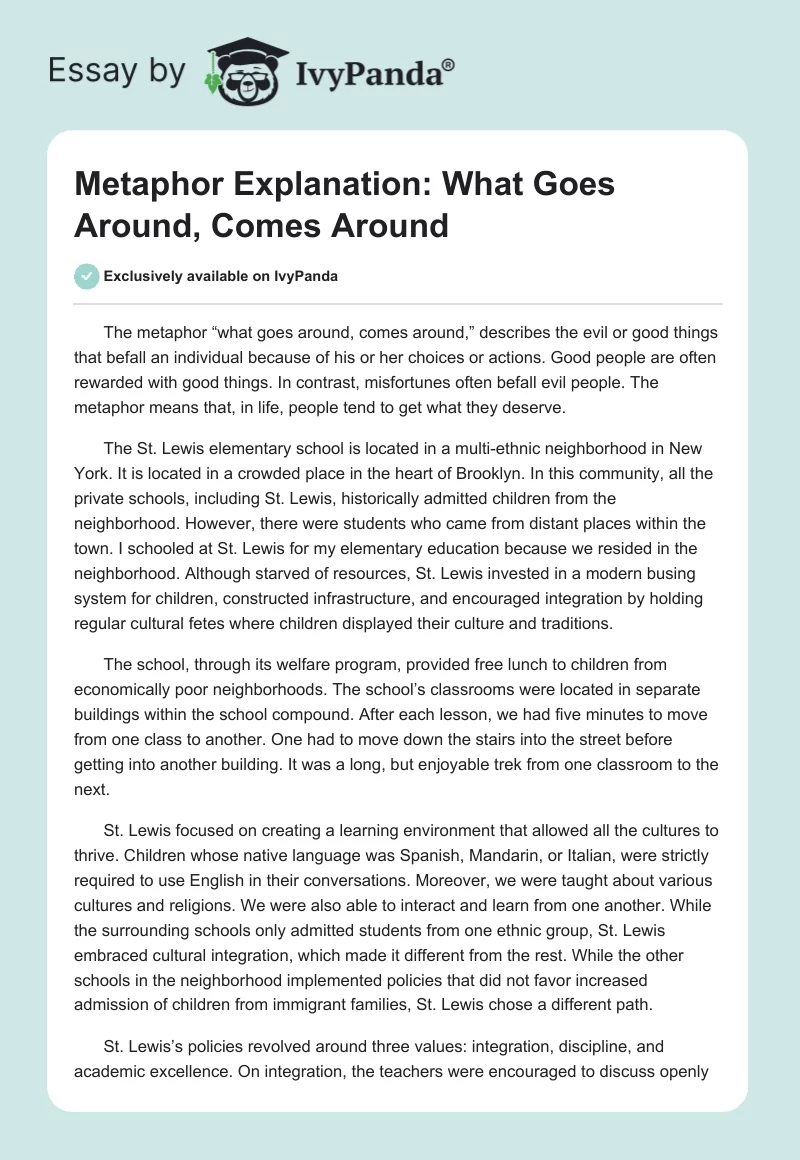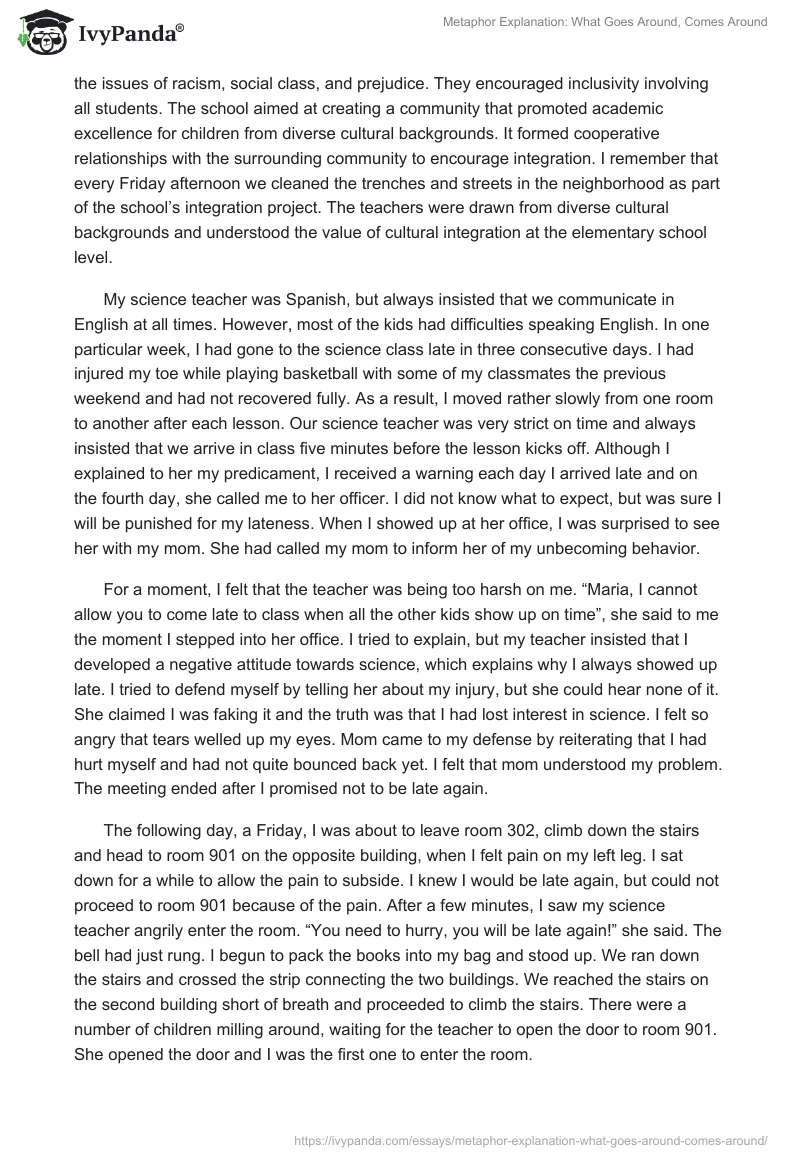The metaphor “what goes around, comes around,” describes the evil or good things that befall an individual because of his or her choices or actions. Good people are often rewarded with good things. In contrast, misfortunes often befall evil people. The metaphor means that, in life, people tend to get what they deserve.
The St. Lewis elementary school is located in a multi-ethnic neighborhood in New York. It is located in a crowded place in the heart of Brooklyn. In this community, all the private schools, including St. Lewis, historically admitted children from the neighborhood. However, there were students who came from distant places within the town. I schooled at St. Lewis for my elementary education because we resided in the neighborhood. Although starved of resources, St. Lewis invested in a modern busing system for children, constructed infrastructure, and encouraged integration by holding regular cultural fetes where children displayed their culture and traditions.
The school, through its welfare program, provided free lunch to children from economically poor neighborhoods. The school’s classrooms were located in separate buildings within the school compound. After each lesson, we had five minutes to move from one class to another. One had to move down the stairs into the street before getting into another building. It was a long, but enjoyable trek from one classroom to the next.
St. Lewis focused on creating a learning environment that allowed all the cultures to thrive. Children whose native language was Spanish, Mandarin, or Italian, were strictly required to use English in their conversations. Moreover, we were taught about various cultures and religions. We were also able to interact and learn from one another. While the surrounding schools only admitted students from one ethnic group, St. Lewis embraced cultural integration, which made it different from the rest. While the other schools in the neighborhood implemented policies that did not favor increased admission of children from immigrant families, St. Lewis chose a different path.
St. Lewis’s policies revolved around three values: integration, discipline, and academic excellence. On integration, the teachers were encouraged to discuss openly the issues of racism, social class, and prejudice. They encouraged inclusivity involving all students. The school aimed at creating a community that promoted academic excellence for children from diverse cultural backgrounds. It formed cooperative relationships with the surrounding community to encourage integration. I remember that every Friday afternoon we cleaned the trenches and streets in the neighborhood as part of the school’s integration project. The teachers were drawn from diverse cultural backgrounds and understood the value of cultural integration at the elementary school level.
My science teacher was Spanish, but always insisted that we communicate in English at all times. However, most of the kids had difficulties speaking English. In one particular week, I had gone to the science class late in three consecutive days. I had injured my toe while playing basketball with some of my classmates the previous weekend and had not recovered fully. As a result, I moved rather slowly from one room to another after each lesson. Our science teacher was very strict on time and always insisted that we arrive in class five minutes before the lesson kicks off. Although I explained to her my predicament, I received a warning each day I arrived late and on the fourth day, she called me to her officer. I did not know what to expect, but was sure I will be punished for my lateness. When I showed up at her office, I was surprised to see her with my mom. She had called my mom to inform her of my unbecoming behavior.
For a moment, I felt that the teacher was being too harsh on me. “Maria, I cannot allow you to come late to class when all the other kids show up on time”, she said to me the moment I stepped into her office. I tried to explain, but my teacher insisted that I developed a negative attitude towards science, which explains why I always showed up late. I tried to defend myself by telling her about my injury, but she could hear none of it. She claimed I was faking it and the truth was that I had lost interest in science. I felt so angry that tears welled up my eyes. Mom came to my defense by reiterating that I had hurt myself and had not quite bounced back yet. I felt that mom understood my problem. The meeting ended after I promised not to be late again.
The following day, a Friday, I was about to leave room 302, climb down the stairs and head to room 901 on the opposite building, when I felt pain on my left leg. I sat down for a while to allow the pain to subside. I knew I would be late again, but could not proceed to room 901 because of the pain. After a few minutes, I saw my science teacher angrily enter the room. “You need to hurry, you will be late again!” she said. The bell had just rung. I begun to pack the books into my bag and stood up. We ran down the stairs and crossed the strip connecting the two buildings. We reached the stairs on the second building short of breath and proceeded to climb the stairs. There were a number of children milling around, waiting for the teacher to open the door to room 901. She opened the door and I was the first one to enter the room.
We were all settled when the teacher noticed that Anne, a friend of mine, was missing. Anne has been always punctual, but that day she came in ten minutes late. My teacher was very disappointed. She began, “oh Anne, Anne, Anne, why are you so late today?” Anne said something about how she forgotten her book at room 302 and had to go back. I jokingly told Anne that she should fake a leg injury. The teacher heard me say something, but did not know what I had said.
She turned and said, “Pardon?” in Spanish. Anne spoke Spanish, but we were forbidden from speaking any language other than English. The teachers, including the science teacher, was very strict and always insisted that we communicate in English, notwithstanding the fact that most of the children were beginners in English. She had trained us never to speak in any other language besides English. As her cardinal rule, she punished any student who spoke in his or her native language. However, that day she broke her own rule when she addressed Anne in Spanish.
After the unfortunate utterance, all the children burst out with laughter and reminded her of all the harsh words she used whenever any of us spoke in his or her native language. “Unbelievable!” remarked Chum, as the entire class burst into laughter. “Oh, Madam, how could you do this?” Alberto asked. “Inconceivable!” said Anne, sending the class into more laughter. “Unbelievable! After all these years you cannot speak in English,” said Stephen, pointing an accusing finger at her. All that while the teacher was speechless. Eventually, she profusely apologized and proceeded with the lesson. The incident made her realize that we had become good English speakers.
It was an unfortunate incident that served to remind our teacher of the challenges that English learners go through. We had a tendency of slipping back to our native languages when communicating with our peers. Given our backgrounds, we found the school’s rule that all students should use English in all communications a bit harsh considering the fact that most of us had a little grasp on the language. While the other teachers allowed students to express themselves in our native language on a few occasions, our science teacher was so strict. It was, therefore, intriguing to hear her address Anne in Spanish. Although she appeared unperturbed by the incident, the ‘slip of the tongue’ no doubt dented her image in the eyes of the students. I could see her unable to stop the ensuing mockery, which, clearly, made her uncomfortable.
After the bell rang, she hurriedly took her lesson book and, in almost a whisper, wished us a good day before departing in a huff. For a moment, I could not imagine that the once ‘mean’ teacher had been subdued by a small slip of the tongue. I bet she wished the lesson could come to an end the moment she uttered those words. Even after the lesson ended, we continued using “pardon” in Spanish in reference to our teacher’s science class remark. In the following days after the embarrassing incident, our science teacher appeared calm and understanding. She no longer rebuked us whenever we inadvertently slipped back to our native languages. It was like a transformation, as she would correct a student’s mistake in speech or writing (grammar) without making any reference to his or her accent. She no longer sneeringly remarked that our spoken English were poor; instead, she encouraged and motivated us to speak good English. The incident served to remind our science teacher that “what goes round, comes around”.
In conclusion, the metaphor “what goes around comes around” warns us to remain conscious of the potential consequences that follow our actions. In the story, our science teacher was so mean to us. She always insisted that we arrive in class on time and use English in all our conversations ignoring the fact that English was not our first language. She embarrassed me in front of my mother over my persistent lateness in class. During her lesson, despite her mean stance, she used Spanish to address Anne. The ensuing mockery made her realize that “what goes around, comes around”. The tables were turned, as she had to endure the students’ tauntings that made reference to her remarks about the quality of our spoken English. Following the incident, she became more supportive and encouraged us to work hard to improve our English skills.


